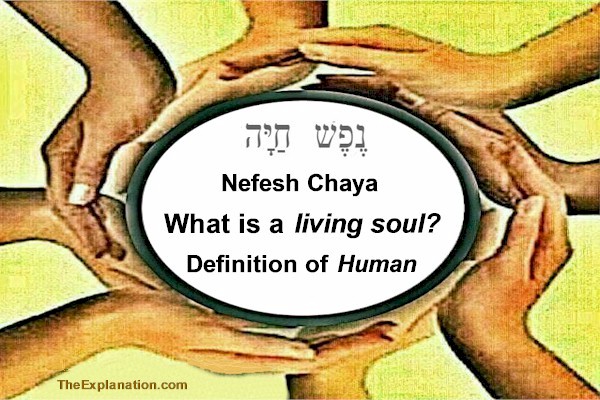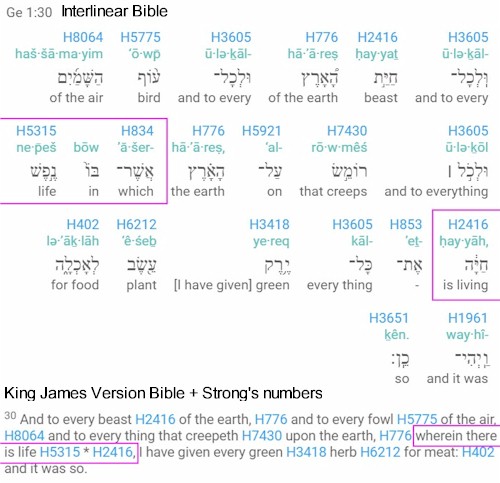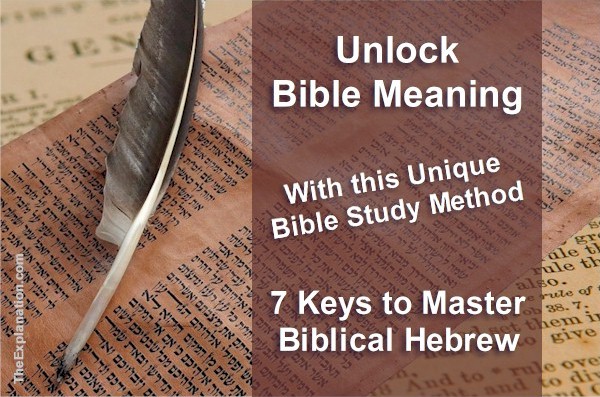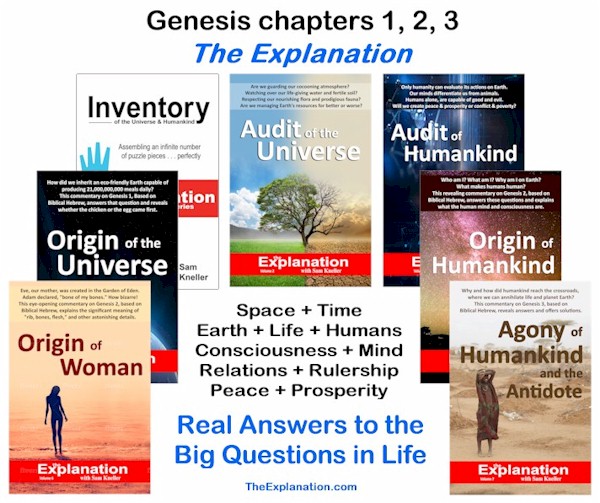Contents
- 1 Nefesh Chaya. Here’s the worldview and focused meaning of this Biblical Hebrew phrase. It’s pivotal to Bible and Psychology comprehension.
Nefesh Chaya. Here’s the worldview and focused meaning of this Biblical Hebrew phrase. It’s pivotal to Bible and Psychology comprehension.

Nefesh chaya. What is a living soul? The definition of what it is to be human.
Genesis 2:7 and the phrase nefesh chaya, translated living soul in the King James Bible, occupy center stage in the entire Bible story. Why? Because they both are the story of humankind. Let me explain.
NB If you really want to know the definition of a human being, you need an open mind to read this post. This is more detailed and precise than other descriptions. Some scripture corroborated affirmations might shock you.
In Genesis 1 The word nefesh (H5315) appears four times in verses 20, 21, 24 and 30 where it’s translated creature and life. It refers to fish, beast, fowl and everything that creeps on earth. In other words, nefesh refers to every single living creature God created up until the first human.
Likewise, Genesis 1 uses the word chai, chaya (H2416) eight times in verses 20, 21, 24, 25, 28, and 30. It also refers to every living thing created by God prior to the first human.
Please verify this at UnlockBibleMeaning.com where you’ll find an Interlinear and Strong’s numbers. See it with your own eyes, don’t take my word for it. It is so important that I’ve also included an image of both the Interlinear and KJV translations. Here’s the point. Both these words, nefesh chaya, are present. They are used together as nesfesh chaya in verse 30, translated in the Interlinear, “in which life is living.” (reading Hebrew right to left). Whereas in the KJV, the translators omitted a word with “wherein is life.”

Nefesh chaya in Interlinear and KJV Bible. Reveals translation short-coming.
Please grasp the vital difference between the Hebrew and KJV translation. The Hebrew says in every beast there is a living life. The KJV says in every beast is life. The implication from the Hebrew is there is a life happening inside the living beast. What is that life animating the animal kingdom?
The Bible says it is the ruach. This life-giving breath and spirit confers on beasts, fish, fowl and crawlers their instinct and special traits for sleeping, hunting, eating, reproducing. The specific survival qualities each species demonstrates and has always shown since their creation.
God’s ruach (careful, this has a small “r” not the capital “R” associated with the Holy Spirit) animates every single living animal.
19 For that which befalls the sons of men befalls beasts; even one thing befalls them: as the one dies, so dies the other; yea, they have all one breath (H7307 – ruach); so that a man has no preeminence above a beast: for all is vanity. (Sam: when it comes to breathing, humans and animals are identical)
20 All go unto one place; all are of the dust, and all turn to dust again. (Sam: God created animals and humans from the earth, dust, and that’s where their bodies return)
21 Who knows the spirit (H7307 – ruach) of man that goes upward, and the spirit (H7307 – ruach) of the beast that goes downward to the earth? (Sam: in addition to breathe, ruach means spirit. Here there’s an enormous difference between animals whose spirit follows the body. But the spirit of humans returns to God who gave it. Read Eccl. 12:7)
The proper translation of Genesis 1:30 tells us there is an essence, something living within a live animal. This essence is the ruach. This is the first error of science, it doesn’t believe there’s a non-material essence. From this point on, there’s irreconcilable understanding.
But that’s not the only comprehension problem. The ruach, the essence animating animals, emanates from God, that’s clear, but more precisely from God’s Ruach, the Holy Spirit. The point the Bible makes, here and elsewhere, is the Holy Spirit is an Essence, the Essence of God. Why can The Explanation affirm this? Because of Genesis 1:2, “The Spirit of God moved over the waters.” The presentation and movement of the Spirit in this context shows that it is the Essence belonging to and used by God to make the Creation. Please read at this link for all the details.
This is the first error of traditional Christian religion, it doesn’t believe the Holy Spirit is an essence. From this point on, there’s irreconcilable understanding.
Humans and Nefesh Chaya
Until this point, prior to the creation of humans, on Day 6 of Creation, it’s been about animals, multiply, and eat. In one word, animals survive as nefesh chaya, the identical phrase we see in Gen. 2:7. From this point forward, it’s about humans and how they thrive. Let’s analyze Genesis 2:7.
And the LORD God formed man (adam) of the dust of the ground, and breathed into his nostrils the breath of life; and man became a living soul.
Genesis 2:7 and nefesh chaya are the beginning, the moment of creation of the first human. By the way, in Biblical Hebrew it uses the term adam, but NOT in the sense of either a name or a gender. We know, of course, the first human created was male, but here in 2:7 it is a generic term referring to human, including male and female (Gen. 1:27), but excluding animals. This is vital comprehension for understanding nefesh chaya in Gen. 2:7. It is not the same nefesh chaya as in Gen. 1:30.
How can The Explanation affirm this?
There are at least a couple of reasons:
- Because Gen. 2:7 says God formed humans. There is no such reference to the animals.
- God breathed the neshama chayim (nishmat chayim in Hebrew) into the human’s nostrils. There’s no such reference to animals. Gen. 2:7 is the very first mention of neshama.
The nefesh chaya in Gen. 2:7 for humans includes three elements.
- The body made from dust.
- The ruach which is a similar essence but different in nature to animals. Confirmed in Ecclesiastes, as we saw above, and we’ll see below.
- The neshama chayim. Which no other physical living being than humans possesses.
The nefesh chaya in Genesis 1:30, referring to animals, ONLY has the ruach, there’s no neshama. This puts humans in a category of their own. The human species, the human race. In Biblical terms, following on from the vocabulary used in Genesis 1, after their kind, we can say, “And God made humans from the dust after their kind.”
Genesis 2:7 tells us there is a material body + the immaterial ruach + the immaterial neshama. ALL three together make up the nefesh chaya. The KJV translators used one word soul. And science and religion have been at loggerheads with each other and each is lacking in comprehension about this primary subject.
The entire Bible is the story of humankind, of billions of nefesh chaya. And neither science nor religion understand what a human being is. Wow. How can they get the story right if they don’t know what or whom they are referring to?
Human Nature
We now know what human and nefesh chaya in Gen. 2:7 means. And we know there are three elements. Let’s move on to a more comprehensive understanding of human nature. It has two parts, human and nature. Each of these parts is immaterial, you can’t touch or measure ithem Last week we saw that in scholarly circles there’s no consensus about what this is. The Bible has revealed there are two non-physical essences that compose a human, a nefesh chaya. Let’s see how human nature corresponds to the neshama ruach combination.
Neshama = Human
What does it mean to be human? The million dollar question. Let the Bible do the talking. Immediately following Gen. 2:7, the creation of the first human, God interacts with him. An exchange that did not take place with any of God’s other creations. This interaction reveals what the neshama and ruach accomplish together. This is human, nefesh chaya. This is what humans alone can accomplish with the neshama.
- Manage the Garden God planted. “Dress it and keep it.” In Biblical Hebrew this phrase means ‘worship and serve,’ the implication is, do this to God.
- The human can choose between two Trees and a lot more to choose their food.
- Humans can name animals and many other items, including their own babies.
- The male could reason there was no mate for him among the animals.
- The male saw and reasoned the female resembled himself. (he said, “she’s bone of my bone”).
- The male understood that he would leave the home of his parents and set up a new home in the institution of marriage, which forms a new family. They would multiply their children as a couple.
- They would have dominion over the Earth, including the animals.
That’s the meaning of human. That’s what the human nefesh chaya can undertake! Only possession of the neshama makes all the above possible. An animal nefesh chaya without the neshama, only possessing ruach, cannot do any of the above. Without neshama, you’re just an animal…
No matter how much you may bodily resemble (like prehistoric beings) a human being. It’s not the body and brain that make a human. It’s the immaterial essences, the ruach and especially the neshama that make one a human.
This is the human in human nature. In this context, let’s discuss two other hard to define descriptions referring to humans; consciousness and cognition.
Consciousness and Cognition
The first human had consciousness and cognition. He was aware of himself, had knowledge, and could reason. All of these attributes are apparent in his singular statement, “she is bone of my bones, flesh of my flesh.” Adam recognized what he was, what she was, and reasoned about their similarity. All because God equipped him with neshama.
The Explanation elaborates on the neshama aspect of nefesh chaya by laying out the singularities of humankind. The human singularities allow humankind to master space-time, we must be creative by using our imagination. Once we’ve imagined our project, we need the education and right choices oriented towards the accomplishment of our project. We then make progress towards that goal meeting the challenges that arise along the way; this alone leads to a sense of success and fulfillment. Only humans can follow that trajectory because of the neshama.
This is not intended to be an exhaustive list, there are other singularities. Note that all singularities are immaterial. You cannot locate them in the brain. Yes, they all have an effect on the brain, but they do not originate there. Read the relationship between consciousness (non-material) and the brain (material neurons, synapses, etc.).
The neshama is what defines human. It is what differentiates us from animals. Note that every single human being that has ever lived or is living is animated by the neshama. Humans are one race with a multitude of cultures and languages. But we all have the same needs, desires and aspirations. Neshama is the human in the human nature each person possesses.
Ruach – Nature
In human nature, ruach is the nature part. Here’s the definition of nature from the article human nature in Wikipedia.
Human nature is a concept that denotes the fundamental dispositions and characteristics—including ways of thinking, feeling, and acting—that humans are said to have naturally. The term is often used to denote the essence of humankind, or what it ‘means’ to be human. This usage has proven to be controversial in that there is dispute as to whether or not such an essence actually exists.
They’ve included the controversial, for science, human essence aspect as well. I’d draw your attention to the thinking, feeling, acting, the doing part of this definition. Here’s a verse that shows we have a natural spirit to which God adds and later will replace with His Spirit.
Ezekiel 36:26 A new heart also will I give you, and a new spirit (H7307) will I put within you: and I will take away the stony heart out of your flesh, and I will give you an heart of flesh.
27 And I will put my spirit (H7307) within you, and cause you to walk in my statutes, and ye shall keep my judgments, and do them.
This might be a moot point, but I’d qualify the neshama as the characteristics describing what human is. Whereas the ruach is more along the line of what humans do, their action in the form of thinking, feeling and acting. Elihu’s ruach, his spirit, was pushing him to get involved in the conversation, which he did decisively.
In Ezekiel, God adds His Holy Spirit. It too causes, helps the receiver to take positive action regarding God’s way of life. Whether it’s the human or God’s s/Spirit (r/Ruach), it involves action.
Note verse 26, there’s mention of a stony heart replaced by a fleshly heart. We have to be careful because there are poetic images here. Just as we’d say, “he was petrified with fright.” He wasn’t turned to stone anymore than a heart can be real stone. There is imagery and use of vocabulary that is not always easy to define.
Sometimes the KJV uses the following translations interchangeably: soul, mind, heart, understanding, wisdom, spirit. Remember, soul covers all three aspects of human. And two of them, neshama and ruach, are non-material, spiritual, both functioning tother as a tandem. These elements are all present, but sometimes it is hard to separate and identify each, particularly in view of the interchangeable translations. My intention in the blog post is not to define or untangle definitively every minute aspect of what a human is or does.
There is the tandem of immaterial essences animating each human being. The neshama analogous with an imprint of God’s qualities on a human scale that He infuses into every human being. Coupled with it is the ruach, the action each human takes starting with capturing information, thinking, feeling and transforming that into activity. The Explanation summarizes this in four parts. Here’s a link to the index of Audit of Humankind where you’ll find these sections of the book.
- How humans function
- How humans socialize
- How humans rule
- How humans reason
Elaborating neshama and ruach helps you see the basics as Genesis lays them out at the very Creation of humans.
Mind and Conscience
The mind and conscience are immaterial elements associated with humans. They are only possible if the neshama is present. I would associate mind and conscience with the ruach, the spirit in humans.
Genesis 41:88 And it came to pass in the morning that his spirit (H7307) was troubled; and he sent and called for all the magicians of, and all the wise men thereof: and Pharaoh told them his dream; but there was none that could interpret them to Pharaoh.
In the New Testament, there are many references to the mind and conscience. The Apostle Paul is a primary source of information and inspiration by his personal example.
6 For to be carnally minded is death; but to be spiritually minded is life and peace.
7 Because the carnal mind is enmity against God: for it is not subject to the law of God, neither indeed can be.
Rom 7:22-23 The war in Paul’s conscience
22 For I delight in the law of God after the inward man:
23 But I see another law in my members, warring against the law of my mind, and bringing me into captivity to the law of sin which is in my members.
God’s Plan in Gen. 2:7 through nishmat chayIM and nefesh chayA
Above, I mentioned how Gen. 2:7 incorporates the entire plan of God. Here’s how. It is the usage of the Hebrew word chai, life. Nishmat chayim (the breaths of God, He breathed into the nostrils) is plural, whereas nefesh chaya (living soul) is singular. Here’s why.
Nishmat chayim (breaths or inspirations of God) is plural. Important because it’s life + life = 2 lives. This relates to the Tree of Lives, yes it’s not the Tree of Life but the Tree of Lives, plural. When you eat from the Tree of Lives, it’s life + life = 2 lives. To understand you need to know what the first life and the second life are. How many know? The plural inspiration of God gives you access to the plural lives of the Tree. Hold this thought.
Nefesh chaya. The word chaya and chayim are identical except nefesh chaya is singular. Only one nefesh. Why? To make a long story short. Because when God breathed the nishmat chayim into the human nostrils, the Biblical Hebrew breathe means both give and take life. With His breath (please read that post), God can resuscitate or blow you away. The neshama gives you access to two lives, but the nefesh only has one life. If humans don’t receive access to the second life, God will blow them away.
The Tree of Lives symbolizes the two lives, the physical transforming into the spiritual life. Rember, Adam and Eve had physical life and God stopped them from eating from the Tree of Lives. Why? Because that represents the second life, conversion, which when exercised leads to Eternal life (2nd life). There must be a period of conversion for the physical human.
The spiritual life starts with repentance and baptism, leading to eternal life. The Tree of the Knowledge of good and evil leading to death symbolizes one life. Only physical life for the single nefesh chaya, the person who chooses not to repent. They refuse the fulness of the neshama chayim, the second spiritual life.
Here’s Bible corroboration, the conclusion of the story of humankind. The just who progress from physical (1st life) to spiritual (2nd), eternal life (chayIM), while the unjust refuse to budge from their physical life (chayA) (read Revelation 21). The righteous receive the neshama chayim, God’s essence of lives forever. The unrighteous receive only the nefesh chaya, one worldly life. They forfeit eternal life.
11 He that is unjust, let him be unjust still: and he which is filthy, let him be filthy still: and he that is righteous, let him be righteous still: and he that is holy, let him be holy still.
12 And, behold, I come quickly; and my reward is with me, to give every man according as his work shall be.
14 Blessed are they that do his commandments, that they may have right to the tree of life, and may enter in through the gates into the city.
15 For without are dogs, and sorcerers, and whoremongers, and murderers, and idolaters, and whosoever loveth and maketh a lie.
The Bible story is that of humankind. Nothing more, nothing less. Christ is the focal point. Why? Because He’s devoted to human beings and their salvation. That’s the relationship between God and humans. God is focusing this part of His plan on the salvation of humankind. The conclusion of Rev. 22, the entire Bible story is, God saves humans. The nishmat chayim God breathed into the first human’s nostrils is now a massive multitude who have fulfilled the nishmat chayim. Their physical life + their spiritual life and are now in their eternal life.
Further Study
The verses below are directly related to Genesis 2:7. What God did at the Creation of the first human, and what God had in mind and inspired Moses to write as scripture, already included the sure thing of Christ’s First and Second Coming. It was already known that there would be a resurrection, a new, second, eternal life. It was known that Christ will MAKE ALIVE. He will make alive that which is dead.
Paul emphasizes this point over and over in 1 Corinthians 15. This make alive to eternal life is why we have the Tree of LIVES and nishmat chayim (plural), the essence of LIVES. Carrying the neshama means we carry the essence of a second eternal life. The nefesh chaya carrying neshama, the potential to be quickened, made alive with eternal life, is the prerogative of every human. It is a sign of being human.
45 And so it is written, The first man Adam was made a living soul; the last Adam was made a quickening spirit.
21 For since by man came death, by man came also the resurrection of the dead.
22 For as in Adam all die, even so in Christ shall all be made alive.
Dig Deeper into The Explanation
Online Study Courses to Uncover the Mystery of Adam and Eve’s Nakedness… with no fuss. Free video mini-course revealing the God-intended meaning of Scripture via Biblical Hebrew. It’s so easy, it’ll blow you away. Join now and add new motivation to your Bible study.
Join The Explanation Newsletter to stay informed of updates. and future events. No obligations, total privacy, unsubscribe anytime, if you want.
The Explanation series of seven books. Free to read online or purchase these valuable commentaries on Genesis 1-3 from your favorite book outlet. E-book and paperback formats are available. Use this link to see the details of each book and buy from your favorite store.

Since you read all the way to here… you liked it. Please use the Social Network links just below to share this information from The Explanation, Nefesh Chaya Meaning. The Most Butchered Bible Term



May it be our desire to partake in this endeavor with a sincere heart, and actively participate in the good works that serve to hasten the endeavor of restoring the gulf between God and humanity.
I somehow got here by way of searching for explanations of “soul sleep” vs. “dead and present with the Lord”… I do not really think I got an answer here, but it certainly was interesting and informative.
If there are any posts on my subject, can you please share them with me ???
Hello Matthew, glad it’s informative. Please read this to what the state of death is. Soul sleep and present with the Lord are other ideas about what happens after death. There are many such ideas, the question is where and how can we know what really happens? Let me know if you have any further questions.